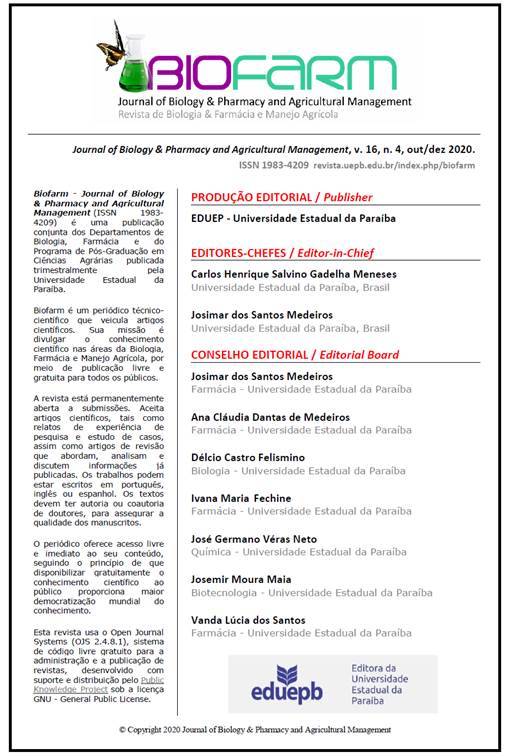MONITORAMENTO DE INSETOS COM ARMADILHAS PET NO CULTIVO AGROECOLÓGICO DE Luffa cylindrica
Abstract
O monitoramento de insetos é uma maneira mais fácil e menos onerosa para um levantamento e possibilita uma tomada de decisão quanto à introdução de medidas de controle. O objetivo do presente trabalho foi monitorar a população de insetos aéreos em área experimental implantada com o cultivo da bucha vegetal (Luffa cylindrica). Para isso, utilizou se 4 tipos sucos de frutas e 1 testemunha (água), totalizando 5 tratamentos: T1 = Água + Caju, T2 = Água + goiaba, T3 = Água + manga, T4 = Água + abacaxi e T5 = água, cada tratamento foi composto por 3 repetições, resultando em 15 unidades experimentais utilizadas no monitoramento e instaladas aleatoriamente. Fez-se o monitoramento em intervalos de 72 horas obtendo 3 monitoramentos consecutivos onde os insetos foram agrupados em suas respectivas ordens. O suco de abacaxi exerceu maior atratividade da macrofauna aérea, onde foram coletados 481 indivíduos. A ordem Diptera (moscas), alcançou maior percentual dentre as ordens estudadas quando usou - se as armadilhas com suco de caju, goiaba, manga e abacaxi (28,64; 3,45; 9,1 e 39,66 % do total de indivíduos, respectivamente). O uso de garrafa Pet para o monitoramento de insetos na cultura da bucha vegetal é eficiente, de baixo custo e acessível para agricultor. Os atrativos alimentares à base de suco de frutas exercem atração sobre os insetos. As ordens Diptera, Hymenoptera e Lepdoptera obtiveram maior número de indivíduos no cultivo da bucha vegetal (Luffa cylindrica).
Downloads
Published
How to Cite
Issue
Section
License
Copyright (c) 2023 BIOFARM - Journal of Biology & Pharmacy and Agricultural Management

This work is licensed under a Creative Commons Attribution 4.0 International License.
Authors and co-authors retain copyright, but cede the right to first publication to the Journal of Biology & Pharmacy and Agricultural Management (BIOFARM).
Copyright encompasses exclusive rights to reproduce and deliver the article in all form and media, including reprints, photographs, microfilms and any other similar reproductions, as well as translations. The reproduction of any part of this journal, its storage in databases and its transmission by any form or media - such as electronic, electrostatic and mechanical copies, photocopies, recordings, magnetic media, etc. - will be allowed only with a written permission from the BIOFARM.
Articles published in BIOFARM will be Open-Access articles distributed under the terms and conditions of the Creative Commons Attribution License (CC BY). The copyright is retained by the author(s). BIOFARM will insert the following note at the end of the published text:
© 2023 by the authors; licensee BIOFARM, Campina Grande, Brazil. This article is an open access article distributed under the terms and conditions of the Creative Commons Attribution License (http://creativecommons.org/licenses/by/4.0/).


